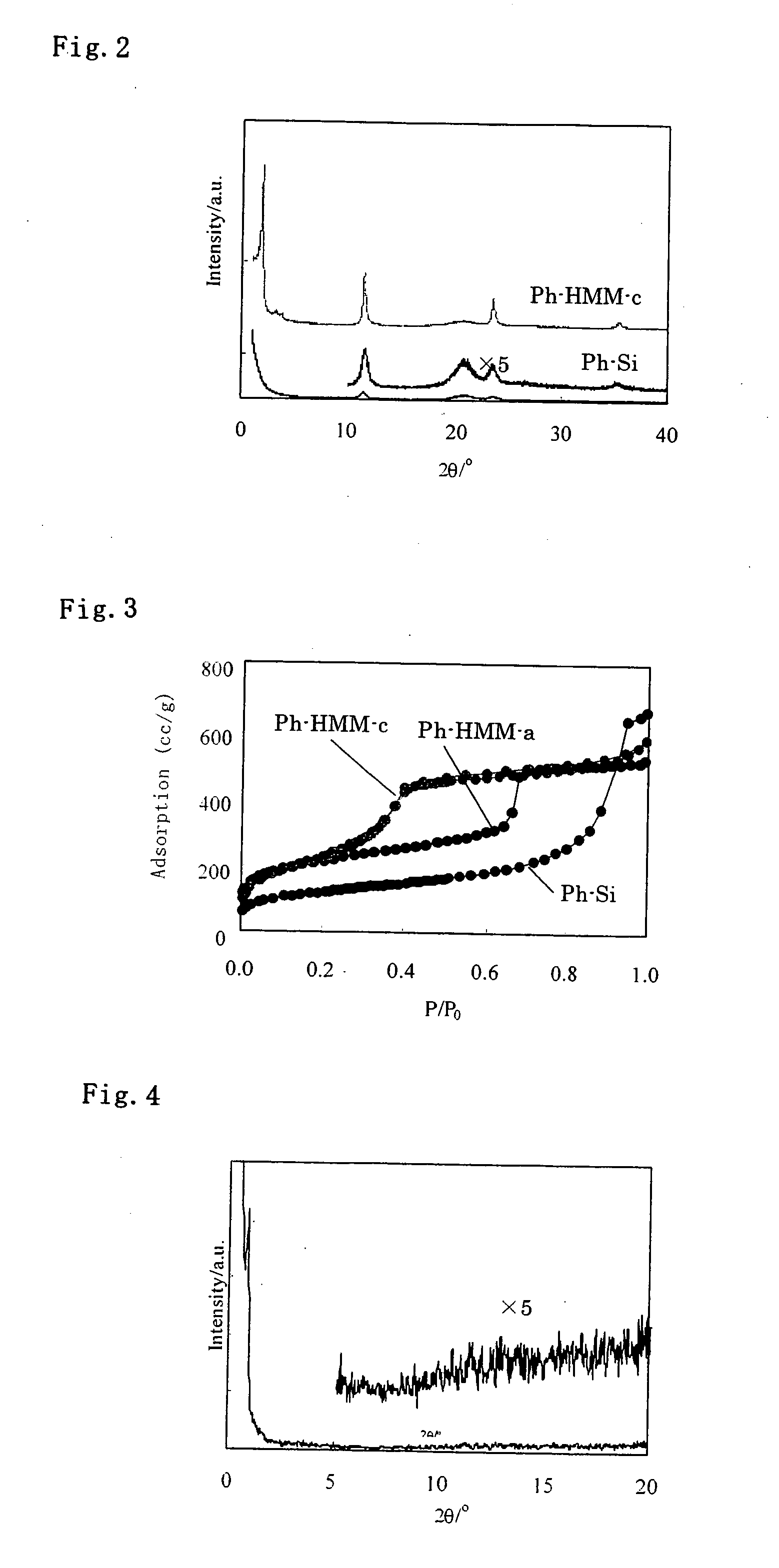Luminescent Material And Method For Producing Same
a technology of luminescent materials and methods, applied in the direction of cellulosic plastic layered products, natural mineral layered products, transportation and packaging, etc., can solve the problems of low luminance efficiency, insufficient luminance, and description of conventional organic luminescent materials, so as to improve luminous efficiency, improve the effect of luminescence efficiency and reduce the effect of luminan
- Summary
- Abstract
- Description
- Claims
- Application Information
AI Technical Summary
Benefits of technology
Problems solved by technology
Method used
Image
Examples
example 1
[0211] Octadecyltrimethylammonium chloride (ODTMA, [C18H37N(CH3)3Cl], available from Tokyo Chemical Industry Co., Ltd., 16.665 g, 47.88 mmol) was dissolved at 50 to 60° C. in the mixture of 500 g of ion-exchange water and 40 g (200 mmol, NaOH) of 6N aqueous NaOH solution. 1,4-bis(triethoxysilyl)benzene (BTEB available from Azmax Co., Ltd., 20 g, 49.67 mmol) was added to the above solution, while being vigorously stirred at room temperature. This liquid mixture was subjected to an ultrasonic device for 20 minutes to disperse the separated hydrophobic BTEB in the aqueous solution. Then, the solution was continued to be stirred at room temperature for 20 hours, and left at rest in an oil bath at 95° C. for 20 hours. The formed white precipitate was filtered and dried, and thereby 8.22 g of the precursor of the mesoporous material containing the surfactant was obtained. 1 g of the precursor was dispersed in 250 ml of ethanol to which 9 g of 36% aqueous HCl solution was added. The soluti...
example 2
[0212] A liquid mixture of 50 g of water and 4 g of NaOH was stirred and 2 g of BTEB was quickly put therein. Then, the solution was exposed to ultrasonic waves for 20 minutes. At this time, the solution began becoming cloudy. Then, after the solution had been stirred at ambient temperatures for 24 hours, it became translucent. Then, the solution was left at reflux at 98° C. for 20 hours and left at rest. Heating caused the solution to begin becoming cloudy in white, and then precipitates were gradually formed. The precipitates were filtered and dried at room temperature to obtain a white powder of phenylsilica composite material (Ph-Si).
example 3
[0213] As poly(ethylene oxide)20-poly(propylene oxide)70-poly(ethylene oxide)20; (P123: Mav=5800) which serves as a triblockcopolymer, one available from Aldrich Corporation was used. 0.99 g of P123 was dissolved in 36 ml of ion-exchange water, and 200 ml of aqueous hydrochloric acid solution (36% by weight) was added therein. 1.01 g of BTEB was added at 0° C. (in an ice bath) to this solution, and the solution was stirred for 1 hour. Then, it was heated at 35° C. and was stirred for 20 hours. This is moved into an airtight container, and heated at 100° C. for another 24 hours. After allowing this solution to cool at room temperature, it was filtered, washed, and the residue was dried to obtain the precursor of the mesoporous material containing the surfactant. The precursor was dispersed in 60 times amount of ethanol, and the solution was stirred for 1 hour or more. Then, it was filtered, dried, and calcined in air at 350° C. for 2 hours to obtain 0.3 g of the mesoporous material (...
PUM
| Property | Measurement | Unit |
|---|---|---|
| pore diameter | aaaaa | aaaaa |
| particle diameter | aaaaa | aaaaa |
| thickness | aaaaa | aaaaa |
Abstract
Description
Claims
Application Information
 Login to View More
Login to View More - R&D
- Intellectual Property
- Life Sciences
- Materials
- Tech Scout
- Unparalleled Data Quality
- Higher Quality Content
- 60% Fewer Hallucinations
Browse by: Latest US Patents, China's latest patents, Technical Efficacy Thesaurus, Application Domain, Technology Topic, Popular Technical Reports.
© 2025 PatSnap. All rights reserved.Legal|Privacy policy|Modern Slavery Act Transparency Statement|Sitemap|About US| Contact US: help@patsnap.com



